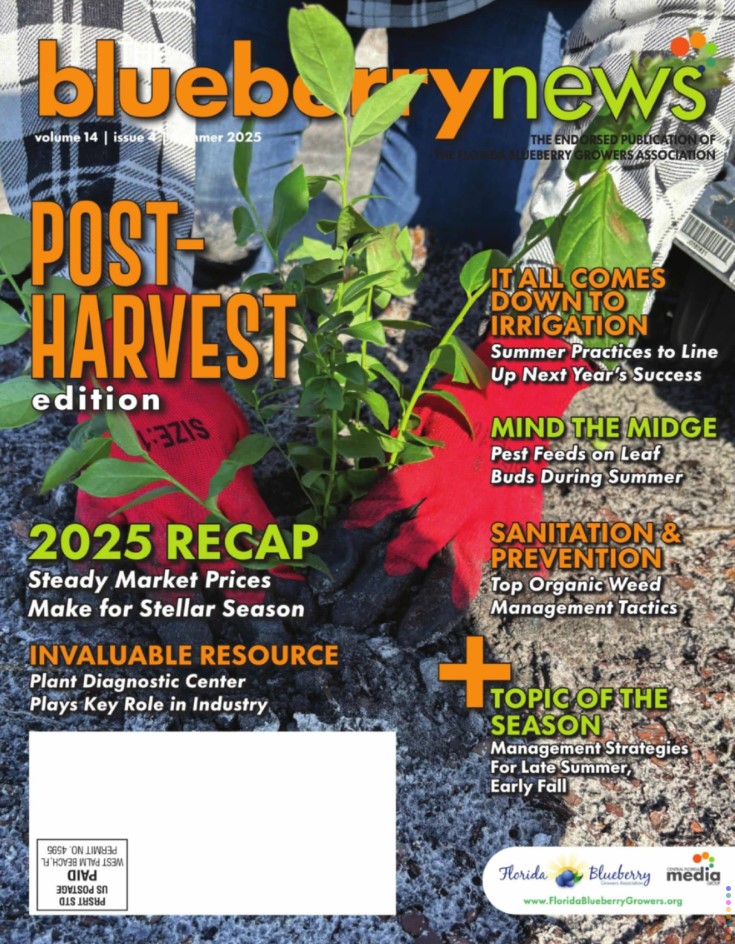Fall/Winter Irrigation and Fertilization Are Key to Bud Formation and Cold Acclimation
Fall may seem like a quiet time in blueberry fields, but important processes are silently occurring such as flower bud formation for next year’s crop and cold acclimation for the upcoming winter. When blueberry plants enter fall, they should have developed a canopy of moderately vigorous shoots with healthy leaves that developed following postharvest pruning during the summer.
Appropriate and well-executed irrigation, fertilization, and pest/disease management programs are needed during the summer to produce and support this healthy summer growth flush. Research has demonstrated that healthy leaves are needed during the late summer and fall for flower bud initiation and development which can begin as early as August in some cultivars, or as late as October in others, and continue throughout the fall. If significant defoliation occurs in early to mid-fall, flower bud initiation and development can be significantly reduced. Both the number of flower buds that develop and the number of berries produced by each individual flower bud can be negatively impacted by untimely fall defoliation. For deciduous production systems in North Florida, this usually means maintaining healthy leaves until late November/early December, or until hydrogen cyanamide (HC) is applied.
In Central and South-Central Florida, where winters are mild, plants may not enter true winter dormancy, or if they do, the cool temperatures (accumulated chill units) needed for them to emerge normally from dormancy are often lacking. Under very low-chill winter conditions, HC applications have been unpredictable and largely ineffective. Therefore, many growers have adopted the evergreen production system, planting cultivars that were selected to perform well in that system. The goal of the evergreen production system is to avoid winter dormancy and the chilling requirement that goes along with it while maintaining a healthy leaf canopy through the winter into spring. This approach requires continued leaf disease management (rust is a particularly problematic pathogen during this time) and some maintenance level of fertilization during fall and winter.
Currently, there is no published data for fertilization of southern highbush blueberries (SHB) using the evergreen production system. However, Dr. Gerado Nunez’s lab initiated a study this year with the goal of evaluating fertilizer practices using the evergreen production system (under tunnel) at the Plant Science Research and Education Unit in Citra, FL. Nunez will be presenting an overview of this project and other new research projects from his lab at the upcoming FBGA Fall Short Course.
Irrigation
Irrigation and fertilization are closely linked. The fertilizer elements must be in the soil solution to be absorbed by plants. Therefore, soil moisture is necessary, but overirrigation can leach fertilizer below blueberry roots where it is unavailable for plant uptake and may contaminate groundwater. Excessive irrigation can also promote certain soil-borne diseases such as Phytophthora. Water use of blueberry is high during the warm months of July, August, and September. However, during October, water use declines due to cooler temperatures and shorter days.
Research conducted over three growing seasons in North-Central Florida showed that the average amount of water used by mature “Emerald” plants declined by about 38% in October compared to September. Water use continued to decline progressively in November, December, and January as temperatures cooled, days shortened, and plants enter dormancy.
Irrigation programs should strive to keep the root zone moist, without applying water below the root zone. Knowledge of crop water demand, average rooting depth, the wetting pattern of the irrigation system, and the water holding characteristics of the soil will help achieve this goal.
Blueberry soils in Florida are somewhat unique in that they are often composed of sand with incorporates pine bark or solid pine bark beds. These types of beds have lower water-holding capacities than many agricultural soils that contain larger percentages of silt and clay. At field capacity, fine sand soil will hold only 0.04 to 0.09 inches of water per inch of soil compared to a loam or silt loam which holds 0.17 to 0.23 inches of water per inch of soil.
The water demand of a blueberry plant will depend on many factors such as weather conditions, plant size (canopy volume), canopy shape and structure, plant health, stage of growth, and other factors. But as stated earlier, plant water demand declines considerably during the fall and winter when compared to the summer growing season.
In a dormant production system in North-Central Florida, the average daily water use of large “Emerald” plants in October was about 1.3 gallons/plant /day and about 0.9 gallons/plant/day in November compared to approximately 2 gallons/plant/day during the summer. However, these monthly averages vary widely depending on the environmental conditions on any given day.
Plant water use during the fall and winter will be influenced by the amount and condition of foliage present, and it will therefore generally be greater for evergreen production systems than for comparable dormant production systems. Various soil moisture monitoring devices are available to help track daily changes in soil moisture and assist with irrigation scheduling. With proper calibration and placement, moisture sensors can help growers determine when to irrigate and for how long.
For more information on soil moisture sensors see UF EDIS document BUL 343, Field Devices for Monitoring Soil Water Content (https://edis.ifas.ufl.edu/pdffiles/AE/AE26600.pdf).
Dr. Michael Dukes’ lab at UF has developed a phone application to assist blueberry growers with irrigation decisions. Dukes will present an overview of this research project at the upcoming Fall FBGA Short Course. The blueberry irrigation app can be downloaded here https://smartirrigationapps.org/blueberry-app/.
For additional information on irrigating and fertilizing Florida blueberries, please refer to UF EDIS documents Irrigating Southern Highbush Blueberry in Florida https://edis.ifas.ufl.edu/pdf/HS/HS1432/HS1432-Dx4nsu6ek6.pdf and Nutrition and Fertilization Practices for Southern Highbush Blueberry in Floridahttps://edis.ifas.ufl.edu/pdf/HS/HS135600.pdf.
CREDIT:
Jeff Williamson, Horticultural Sciences Department, UF
& Doug Phillips, blueberry extension coordinator, UF/IFA





